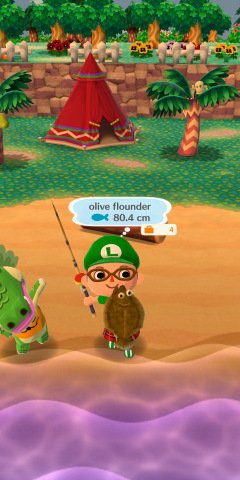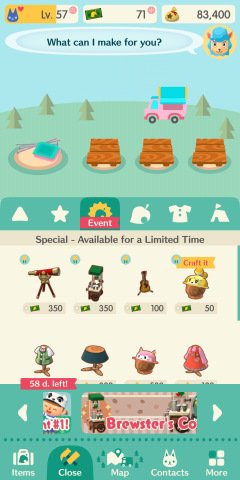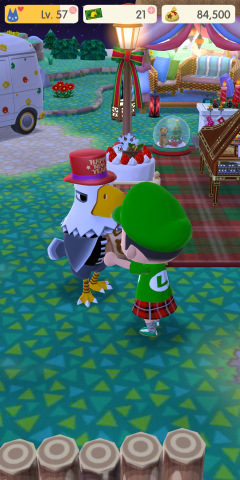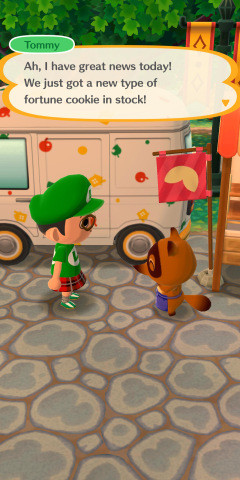
Nintendo keeps killing it with its mobile games, so it’s probably no surprise to see Animal Crossing: Pocket Camp on this list.
You may also be interested in: Nioh 2 The Tengu’s Disciple DLC Xbox One Version Full Game Setup Free Download
Pocket Camp puts players in control of their very own campsite, which you’ll decorate with items you’ve crafted yourself. The fancier you make your camp, the more animals you’ll attract, and the more adventures you’ll enjoy.
This might be a mobile game, but it offers countless hours of fun, and a staggering list of items to craft and collect. You will also enjoy staple Animal Crossing experiences like bug catching, fishing, and fruit gathering.
As someone who couldn’t wait for it to come to the UK and downloaded a sneaky .apk file of the Australian version for my Android phone the day after launch, that means today marks exactly six months since I started playing it.

While most sites review games right after they’ve launched, not many of them track their progress months later. Although it’s obvious why this is the case – new games get more traffic than old ones – it’s sometimes a missed opportunity, especially when it comes to mobile games.
Mobile titles, more than any, are often treated as ‘services’ and are constantly updated, patched, evolved and enhanced with new features, modes, characters, and various other whizz-bangs. Play a mobile game at launch and play it again a few months later and you’ll often find two very different beasts.
Sometimes a barebones game becomes one that’s packed with content. And sometimes a well-balanced game is ruined by publisher greed when the user base grows and the opportunities to make money through microtransactions get too great (I’m looking at you, WWE Champions).
With that in mind, I’ve decided to review Animal Crossing: Pocket Camp six months after it launched. It’s changed a fair amount since October 2017, but is that necessary for the better? My answer is “it depends”, which is no doubt frustrating for you because now it means you have to read on.
While the main Animal Crossing games have long been considered a series where the player has the freedom to do whatever they like, Pocket Camp has one clear central mechanic: collect shit for folk.
Practically every major thing you can do in the game stems from the main aim of gathering fruit, shells, fish, and bugs and traveling from location to location, fulfilling the specific requests of the animals you’ll find there.
It’s the main way to get materials, you see: every time you deliver a helping of squids, apples, butterflies or what have you, you’ll be rewarded with some bells (the game’s traditional currency) and a handful of building materials: wood, steel, cotton, paper or preserves.

These materials are what you need to craft most of the furniture in the game, which you do by calling Cyrus from New Leaf and placing an order. You then have to wait anything from a minute to 12 hours (depending on the complexity and value of the item), and then it’s ready for you to place in your camp.
Don’t want to wait eight hours for your balloon table to be built? Then you can speed up the process by spending some Leaf Tokens. This is a mobile game, after all.
Yes, Leaf Tokens are your classic mobile currency, which can be earned through in-game activities or topped up using real cash.
Although there are a couple of items that can only be bought with Leaf Tokens – on day one this consisted of chairs that let Tom Nook and KK Slider make guest appearances – you get enough Leaf Tokens in the early stages to buy them (as long as you can resist the urge to spend them on other things, of course).
The general aim, though, is to invite as many animal guests to your camp as possible by doing three things:
• collecting enough stuff for them until their friendship meter hits a required level
• crafting the five pieces of furniture they like
• laying that furniture out in your camp and inviting them over
Doing this will add the animal in question to your group of campsite residents, or put them on a list of possible residents if your campsite is full.
And that’s the ‘game’ element of Pocket Camp: since it’s a much more limited game compared to its console and handheld siblings, the only real challenge you can set yourself is recruiting every animal in the game to your campsite, and trying to complete your furniture catalog in the process.
On day one, then, the verdict was straightforward enough: rather than a wide-open game with a huge variety of things to do, this was a more task-focused Animal Crossing with more obvious goals and a microtransaction system that, initially at least, seemed reasonably fair.

It quickly became the consensus among most Pocket Camp players that the constant grind of logging in every four hours to collect fruit, shells, bugs, and fish and give them to animals was getting old fast.
To Nintendo’s credit, then, it regularly added special events to the game – designed to keep players logging in – while occasionally implementing new features that were intended to add a bit more variety.
The first big event was the Holiday 2017 event, which let players earn special Christmas-themed furniture and clothing.
The method to get it all was simple: while doing your usual errands for your animal chums, as well as the bells and materials they occasionally also gave you a couple of candy canes for your trouble. These candy canes could then be used to order the Christmas furniture.
This was a relatively well-balanced event. If you played the game fairly frequently, as I did, it was perfectly possible to earn enough candy canes to buy every Christmas item and still have plenty leftover.
If you didn’t play the game a lot and didn’t get enough candy canes but wanted the Christmas stuff, you could spend Leaf Tokens to buy what you needed instead (and, naturally, if you didn’t have enough you could buy more with real money).
This is one of the most common forms of microtransaction you get in mobile games and it’s fair to say it’s one of the least contentious. Make it possible for regular players to get the goodies without paying, and casual players can pony up the cash if they don’t want to put the effort in.
It’s the gaming equivalent of paying for someone to put together the Ikea furniture you ordered instead of building it yourself: it’s lazy, but it saves time and if you can afford it then fuck it: at least someone’s getting paid for their work.
So far so good, then. Microtransactions very much present, but not to the extent that my own goal – filling the furniture catalog – was made impossible for a non-paying player.
There have been a couple of similar events since, and they’ve worked similarly. Whether it’s collecting Countdown Charms to unlock New Year’s furniture in late December, snowflakes to get winter sports furniture in January, crystals to unlock crystal furniture in February or mushrooms to earn Mario-themed stuff in March, all these events have been very much achievable if you put in the effort (or grind, if you will).
These events haven’t been the game’s only additions, though, and that’s where the problems come in.
A month after the game’s main launch, a garden area was added to the campsite. This lets you plant flowers and while it isn’t my cup of tea, it seemed to be relatively popular among some.
However, it quickly became clear that the main reason for the garden was the regular flower-based events, in which players have to continually plant, water, harvest and re-plant flowers in an attempt to encourage butterflies, bats or ladybugs to land on them.
These events come in phases: usually, the first phase consists of two types of creature – a common and rare one – and the second phase adds an even rarer one. Every time they land on your flowers, you can try to catch them, and the more you catch the more exclusive items you unlock. When trying to catch them, your success rate depends on the rarity of the creature: the rarer it is, the more likely it’ll fly through your net.
Alternatively – and here’s where it gets a bit iffy – you can ask Lloid the Gyroid to catch the bugs for you. This results in a guaranteed catch, but it costs you Leaf Tokens each time.
The first of these events was Rover’s Garden Safari in January, and despite trying my very best and playing the shit out of the game for ten days straight, I wasn’t able to catch enough rare butterflies to get every item. Just like that, my quest to complete the catalog was no longer achievable.
There have been a couple more flower-based events since, and every time I’ve found it pretty much impossible to get all the limited-time items on offer. The game encourages you to add friends to the game and trade bugs with them, but my friend list is bloody massive and I had people regularly adding bugs to my flowers: it didn’t make a difference, because I was barely catching any without turning to Lloid for help (which I refused to do).
The final straw for me came just a couple of weeks ago, with the addition of fortune cookies. With this new feature, Nintendo is no longer trying to disguise the fact it wants you to spend (and buy more) Leaf Tokens: it’s flat out added loot boxes to the game.
Fortune cookies give you special furniture and clothing items when you buy and eat them. Some fortune cookies can be bought with bells, which is fair enough, but the special ones – you guessed it – can only be bought with Leaf Tickets.
This very morning, six months after launch, a new type of fortune cookie was added: Hopkins’s Game Cookie. Each cookie costs 50 Leaf Tickets, and each contains a retro Nintendo system or a display stand for them.
There are ten items in total, ranging from a Switch to a Wii U, to even a Virtual Boy. This is designed to appeal to long-time Nintendo fans.
It’s also designed to appeal to their wallets, sadly. In true loot box fashion, fortune cookies can give you an item you already have, so if you buy a cookie and it has a Wii Balance Board in it, there’s every chance your next cookie will give you another one.
Even worse, check out the odds for some of them. The likelihood that you’ll get a Switch is just 3%. This means that on average you’ll need to buy 34 fortune cookies to find one (maybe more, maybe fewer).
That’s 1700 Leaf Tickets. For reference, a pack of 1200 costs £38.99 and a pack of 600 costs £20.49 (there are no packs of 500). So if you’ve run out of Leaf Tickets – which is likely given there’s currently 850 Leaf Tokens’ worth of special furniture that can only be bought with them – you’re talking £60 on average to complete the set.
This may not come as a huge surprise but there’s not a snowman’s chance in the Sahara I’ll be paying for that. As such, that’s another series I won’t be able to complete, and this one sting more because we’re talking retro Nintendo systems.
As such, I now find myself in the situation where I think it may be time to draw a line under my time with Animal Crossing: Pocket Camp and wait patiently for the inevitable Switch version instead.
When it first launched it was an impressive “oh look, it looks just as good on a phone” moment, but it’s since become a daily ritual of collecting stuff and handing it over, and it’s one I don’t enjoy any more.

Aye, good news for you, ya prick
Recent updates have tried to mix things up by changing the requests: sometimes they now ask you to find their missing item, and sometimes they’ll ask you to choose a bug or piece of fruit for them instead of asking for one specifically. But this doesn’t make it less repetitive: you’re still doing the same thing over and over again, it’s just that sometimes the steps change slightly.
For many, Animal Crossing games have always been about the daily ritual. For a good year when I lived in London, I would spend an hour-long commute to work playing New Leaf on the 3DS and doing my usual routine: shaking the trees, hitting the rocks, collecting the fruit, watering the plants, visiting the shops and talking to my villagers.
On the way home, I’d then do my evening routine, which consisted of visiting the island section and fishing for sharks and other rare fish while listening to podcasts on my iPod to keep my mind busy.
The daily grind isn’t a new thing, then. In a way, for people like me, it’s what makes Animal Crossing what it is. The difference is that in other versions of the game, that daily grind serves a purpose: it’s part of building towards a greater goal.
Making your house bigger. Upgrading the nearby shops. Adding new amenities to your village. There was always something you were saving up for, and every day as you earned new bells you could feel yourself inching towards that goal.
In Pocket Camp, the only thing the daily grind has you working towards is buying furniture you don’t want, to tempt animals you don’t like to visit a campsite you don’t want them to live in, just so you can tick them off your checklist.
It wasn’t initially clear whether Animal Crossing would end up becoming a relatively well-liked mobile game like Fire Emblem Heroes or Super Mario Run, or whether it would end up outstaying its welcome like Miitomo did. In recent times I’ve started swaying towards the latter.
What started as a basic but relatively well-balanced game has now turned into a slightly more complex one, but one that now tries to make you fork over cash at every opportunity.
SkateBIRD iPhone Mobile iOS Version Full Game Setup
